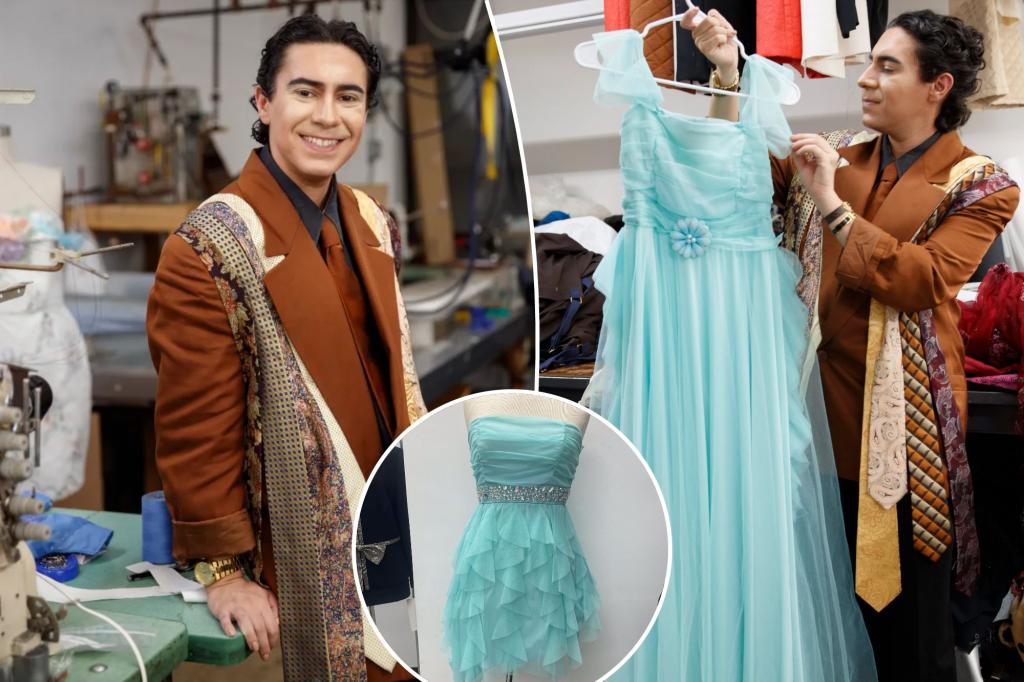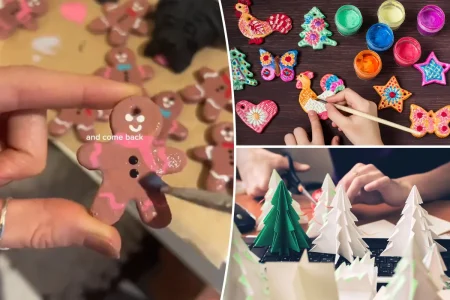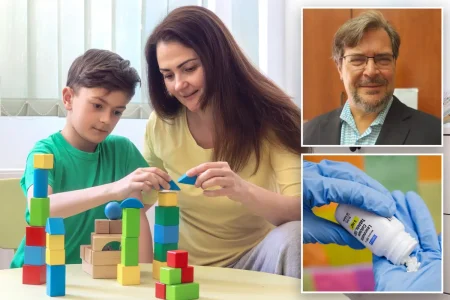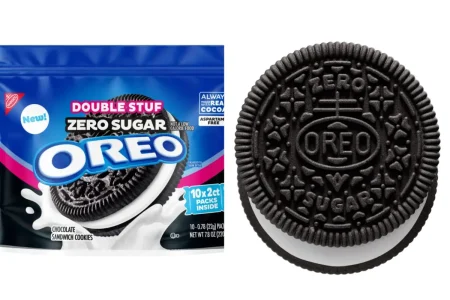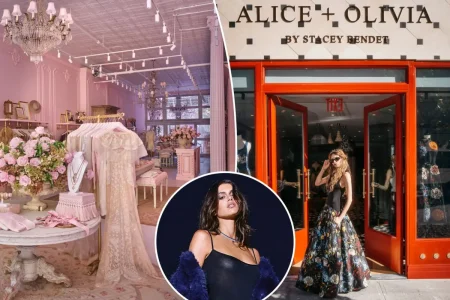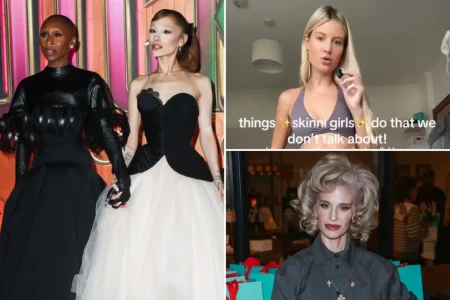From Thrift to Haute Couture: Evan Hirsch’s Transformative Fashion Journey
In the heart of Midtown, a 28-year-old designer named Evan Hirsch is redefining fashion with a simple yet revolutionary philosophy: “One man’s trash is another man’s couture.” Hirsch captured the internet’s attention in March when he transformed a modest $6 Goodwill sheath into a dazzling cocktail dress, sparking millions of views across social media platforms. This viral moment was just the beginning of his journey into sustainable fashion, culminating in an invitation to showcase his unique vision at New York Fashion Week. His upcoming collection, aptly named “Found Opulence,” features 30 breathtaking looks created entirely from items sourced through Goodwill’s auction site and local stores in New York and New Jersey. The nonprofit gave him creative freedom, telling him to “go wild” – and that’s exactly what he did. Among his ingenious creations are a bedsheet reimagined as a strapless sheath adorned with fabric flowers, a 1980s prom dress transformed into a 1950s-inspired cocktail frock, and a burnt-orange gown enhanced with embroidery and beading from traditional Indian garments. With theatrical flair, his runway show promises dramatic reveals, including a sequined cape concealing a “sexy secret” and an ensemble crafted entirely from vintage brooches.
Hirsch’s fascination with fashion’s transformative power began in his childhood in Dix Hills, Long Island. Initially dreaming of Broadway stardom, he quickly realized his acting talents were limited – consistently landing roles as background elements like “Tree” or “Villager Number Four” in school productions. Instead of abandoning theater altogether, he found his calling in the costume department, where he discovered joy in transforming his suburban classmates into characters from different eras. This early experience ignited his passion for period pieces and costume alteration, leading him to pursue fashion design at Drexel University in Philadelphia. His first creation – “a cotton tube that you could not get on or off” that risked dislocating shoulders – was admittedly “awful,” but it marked the beginning of his experimental journey. During college, Hirsch began developing his signature style: garments that could be worn multiple ways or dramatically transformed – mini dresses unfurling into ballgowns, ponchos converting into 8-foot trains. This theatrical approach to fashion design reflected his desire to “impress the audience and shock them and get a reaction,” connecting his work to his theatrical roots.
Drawing inspiration from diverse sources including “RuPaul’s Drag Race,” “America’s Got Talent,” and avant-garde designer Hussein Chalayan – famous for his self-transforming garments – Hirsch was captivated by the magical quality of metamorphic fashion. When he first encountered Chalayan’s “undressing dress” that unzipped itself, Hirsch was determined to unlock the secrets behind such transformative creations. His early attempts were “a little loofah-ish, a little bit voluminous, a little top-heavy,” but through persistent refinement, he developed a technique that would eventually generate “hundreds of millions of views on social media.” After graduating in 2019, Hirsch worked as a technical designer for a children’s wear company before launching his independent label in 2022. His transformative garments gained traction on TikTok, where he now boasts over 558,000 followers, and earned him appearances on daytime talk shows like “Tamron Hall” and “Sherri,” establishing his reputation as an innovative designer with a flair for the dramatic.
In March, Hirsch undertook a project that would change the trajectory of his career: purchasing a red one-shoulder cocktail dress from Bebe for just $6, he meticulously hand-sewed gold beads onto it, added a sheer red overlay to transform it into a gown, attached his designer tag, and returned it to the Goodwill rack where he’d found it. This creative act of fashion philanthropy captured the public’s imagination, amassing 7 million views and catching the attention of major publications like People magazine. The viral moment also caught Goodwill’s eye, leading to a collaboration proposal that Hirsch expanded into the concept for an entire collection made from thrifted finds. To add an element of creative challenge, most garments were sent to him in “blind boxes” from ShopGoodwill.com, forcing him to work with whatever arrived – a constraint that only heightened his creative problem-solving. After his New York Fashion Week show, fifteen of these transformed designs will be auctioned on ShopGoodwill.com, with all proceeds supporting Goodwill’s workforce development programs, adding a philanthropic dimension to his artistic expression.
Hirsch’s role as Goodwill’s “resident fashion expert” will continue throughout the year, potentially evolving into a long-term partnership that aligns perfectly with his evolving vision for sustainable fashion. What began as a creative experiment has become central to his brand identity, transforming his initial resistance to sustainability – “Leave me alone – it’s hard enough to run this business!” – into genuine enthusiasm. Through hands-on experience, Hirsch discovered that sustainable fashion isn’t just an ethical choice but an enjoyable and creatively stimulating approach to design. “This isn’t hard. This is fun. It’s easy and it’s better for the planet,” he reflects, hoping his work demonstrates how accessible sustainable fashion can be. His journey from thrift store racks to New York Fashion Week exemplifies how creativity, sustainability, and transformation can coexist beautifully in the fashion world. In challenging the industry’s wasteful tendencies, Hirsch has found his purpose: revealing the hidden potential in discarded garments and inspiring others to see sustainability not as a limitation but as an opportunity for greater creative expression.
Hirsch’s “Found Opulence” collection stands as a testament to fashion’s potential for rebirth and reinvention, challenging the notion that high fashion requires new materials or exorbitant budgets. In transforming forgotten thrift store items into runway-worthy pieces, he demonstrates that sustainable fashion can be just as captivating, luxurious, and boundary-pushing as its conventional counterparts. His work bridges the gap between accessibility and high fashion, democratizing creativity while elevating discarded materials to art. As the fashion industry grapples with its environmental impact, innovators like Hirsch offer a glimpse into a more sustainable future – one where designers view limitations as creative challenges and where transformation becomes not just a theatrical element but a fundamental philosophy. Through his partnership with Goodwill and his growing social media influence, Hirsch isn’t just creating beautiful garments; he’s crafting a new narrative about fashion’s relationship with consumption, waste, and creative possibility, proving that sometimes the most extraordinary fashion statements begin with the most ordinary materials.




